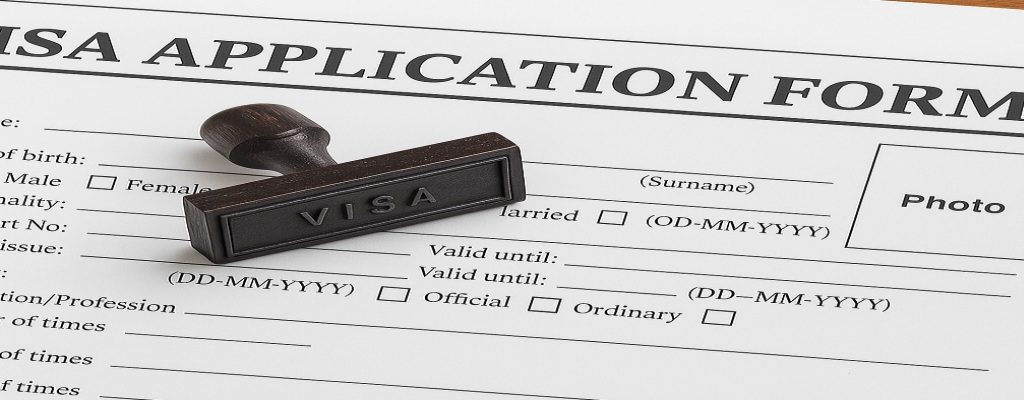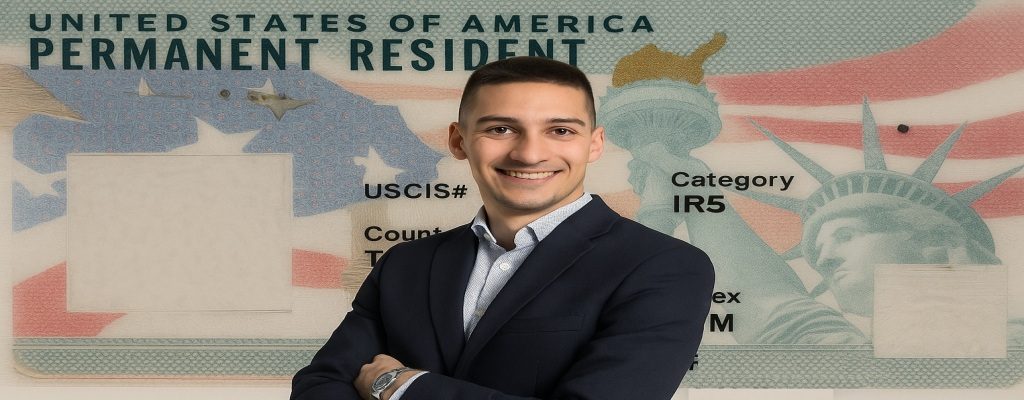This report explores how Turkish energy companies can strategically expand...
Read MoreHuseyin Emre Eney
Attorney at Law
Selen Esen
Paralegal
Huseyin Emre Eney Selen Esen
Attorney at Law Paralegal
Immigration Law Expert – Akalan Law Firm Immigration Law Expert – Akalan Law Firm

What Is Green Card and How Can You Get a Green Card from USA If You Already Live There?
For many individuals living in the United States and seeking permanent residency, understanding the Green Card process is the first and most crucial step. If you’re already in the U.S. and wondering how to obtain a Green Card from USA, this guide is tailored specifically for you. A Green Card—officially called a Permanent Resident Card—grants you the legal right to live and work permanently in the United States.
In this article, we will walk you through every key aspect of the process, from who is eligible and how to apply, to common mistakes to avoid and how long it really takes. Whether you’re applying through marriage, employment, family sponsorship, or the Green Card lottery, you’ll find everything you need to make informed and confident decisions on your journey to lawful permanent residency.
A Green Card—officially known as a Permanent Resident Card—is a legal document issued by the U.S. Citizenship and Immigration Services (USCIS) that allows non-citizens to live and work permanently in the United States. Holding a green card confers lawful permanent resident (LPR) status and represents one of the most significant milestones on the path toward U.S. citizenship.
According to USCIS, individuals who obtain permanent residency through a green card application are granted the legal right to:
In essence, the purpose of a green card is to provide a long-term legal foundation for immigrants who wish to make the U.S. their permanent home. This status is typically obtained through family sponsorship, employment offers, asylum or refugee status, or the Diversity Visa Lottery program. For many applicants, the process begins when they apply for a green card either from inside the United States (adjustment of status) or from abroad (consular processing).
A key question for newcomers to U.S. immigration law is: what is the difference between a visa and green card?
A visa is generally a temporary permit issued by the U.S. Department of State, allowing a foreign national to enter the U.S. for a specific purpose—such as tourism, study, or temporary work. There are two main types of visas:
A green card, by contrast, grants permanent lawful status and is not tied to a specific employer, educational institution, or expiration date in the same way most visas are. While a visa allows entry, a green card allows residency.
Furthermore, as detailed by USA.gov, having a visa does not automatically lead to permanent residence. To remain in the country beyond a visa’s expiration, individuals must transition to immigrant status and formally apply for a green card through USCIS channels.
For anyone considering permanent settlement in the U.S., understanding this distinction is essential before beginning the green card application process.

Obtaining lawful permanent residency—commonly known as a Green Card—in the United States is possible through a variety of immigration pathways. While the eligibility criteria and procedures vary, the most common categories recognized by U.S. Citizenship and Immigration Services (USCIS) include options such as green card through family, green card through employment, and green card through refugee or asylee status. This article will provide an overview of these major categories.
To understand how to be eligible for a green card, applicants must meet specific green card eligibility criteria based on their circumstances.
One of the most common routes to obtaining lawful permanent residency in the United States is through family relationships. A family-based Green Card is available not only to immediate relatives of U.S. citizens—such as spouses, unmarried children under 21, and parents of U.S. citizens who are at least 21 years old—but also through broader family preference categories.
According to U.S. Citizenship and Immigration Services (USCIS), U.S. citizens may petition for:
Lawful permanent residents (green card holders) may petition for:
In addition, other family-based categories include fiancé(e)s of U.S. citizens and their children (admitted to the U.S. under K-1 or K-2 visas), widows or widowers of U.S. citizens (if the marriage existed at the time of the citizen’s death), and individuals eligible to self-petition under the Violence Against Women Act (VAWA), including abused spouses, children, or parents of U.S. citizens or lawful permanent residents.
There are multiple family-based Green Card categories, and the process, eligibility requirements, and waiting times vary depending on the preference level and the nature of the relationship. For example, immediate relatives of U.S. citizens are not subject to annual caps, often resulting in faster processing times compared to preference-based categories like siblings or adult children.
Applicants are generally required to provide documented proof of the qualifying relationship and submit the appropriate forms—most commonly Form I-130 (Petition for Alien Relative) and, when eligible to adjust status in the United States, Form I-485 (Application to Register Permanent Residence or Adjust Status). Seeking the assistance of an experienced family-based immigration attorney can help ensure that the petition is accurately prepared and submitted, reducing the likelihood of delays or denials.
Typical family-based Green Card processing times range from approximately 7 months to several years, depending on factors such as the petitioner’s immigration status, the specific relationship category, and the applicant’s country of origin due to annual per-country visa limits.

A second major pathway to a green card is employment sponsorship. An employment based green card is typically reserved for foreign nationals with job offers from U.S. employers, individuals with extraordinary abilities , or professionals in fields with labor shortages.
USCIS classifies immigrant workers into three preference levels:
In addition to these categories, physicians may apply for a Physician National Interest Waiver if they agree to work full-time in a clinical setting within a designated underserved area for a specific period of time and meet other eligibility criteria.
Another employment-based option includes the Immigrant Investor (EB-5) program, which is available to individuals who invest at least $1,050,000 (or $800,000 in a targeted employment area or infrastructure project) in a new commercial enterprise in the U.S. that creates at least 10 full-time jobs for qualifying employees.
Applicants under employment-based categories typically must file Form I-140 (Immigrant Petition for Alien Worker), and in many cases, a labor certification from the U.S. Department of Labor is also required. The timeline for processing employment-based Green Cards can vary significantly depending on the preference category, availability of visa numbers, and the applicant’s country of origin.

The Diversity Immigrant Visa (DV) Program offers another pathway to lawful permanent residency in the United States. Administered by the U.S. Department of State, the DV Program makes up to 50,000 immigrant visas available each fiscal year to individuals from countries with historically low rates of immigration to the United States. Winners are selected through a randomized lottery process.
Most DV lottery winners live outside the United States and obtain their immigrant visa through consular processing. However, a limited number of selectees may already be lawfully present in the U.S. in a nonimmigrant or other eligible status at the time of selection. These individuals may be eligible to apply for adjustment of status through USCIS.
To adjust status in the U.S. based on DV selection, applicants must:
Visa number availability is governed by the monthly Visa Bulletin, specifically Chart B (Dates for Filing) and Chart A (Final Action Dates), which determine when DV selectees may file or expect final decisions on their cases. Each DV applicant is assigned a unique rank number, and only those with a rank number below the cut-off listed in the Visa Bulletin for their region may proceed.
Because the DV program operates on a strict fiscal-year timeline, selectees must act quickly to prepare and submit all required documentation within the same fiscal year. Failure to file Form I-485 or complete consular processing before the end of the fiscal year will result in the loss of eligibility, regardless of selection.
Due to the time-sensitive and complex nature of the Diversity Visa process, consulting with an immigration attorney is strongly advised to ensure proper filing and timely submission of all required forms and evidence.
Eligibility Requirements for Diversity Visa Lottery 2026:
Before applying, participants must:

Individuals who have been granted refugee or asylum status in the United States may be eligible to apply for lawful permanent residency (a Green Card) after meeting specific legal requirements. Although the underlying bases for refugee and asylum status differ, the adjustment process for both follows a similar framework.
-Refugees
Refugees admitted to the U.S. are required by law to apply for permanent residency one year after their entry. A refugee green card application typically begins with Form I-485, supported by proof of refugee status and presence in the U.S.
Key points for refugee green card applicants:
The refugee green card is not subject to visa quotas, which may lead to faster approval in some cases.
-Asylees
Like refugees, individuals granted asylum may apply for a green card for asylees one year after receiving asylum status. The green card for asylee process also involves Form I-485 and requires continuous presence in the U.S.
Important considerations for asylee green card applicants:
A frequently asked question concerns whether asylees may travel to their home country after obtaining a Green Card. Although lawful permanent residents may travel internationally using a refugee travel document or Green Card, returning to the country of claimed persecution may raise serious concerns with USCIS. Such travel could be interpreted as an indication that the fear of persecution no longer exists, potentially undermining the basis of the original asylum grant. As such, it is highly advisable to seek legal counsel before making any travel plans involving the country of feared harm.

A Green Card application requires careful preparation, strict adherence to U.S. immigration regulations, and the timely submission of various government forms, supporting documentation, and fees. Applicants must also satisfy specific eligibility requirements depending on the immigrant category under which they are applying.
This section provides a step-by-step overview of the Green Card application process, including:
All steps are based on official U.S. Citizenship and Immigration Services (USCIS) procedures and current immigration guidelines. Given the high stakes and potential complications involved, applicants are strongly encouraged to seek professional legal assistance to help navigate the process efficiently and accurately.
Applying for a Green Card—officially called a Permanent Resident Card—can be a critical step toward building a long-term life in the United States. Whether through family sponsorship, employment, marriage or the green card lottery application, the process involves legal, financial, and procedural complexities. This section breaks down how to apply for a Green Card, the required documents and forms, and the common mistakes to avoid—based on official USCIS procedures.
1- How to Apply for a Green Card
The green card application process begins by determining your eligibility and then submitting the correct petition and immigration forms. Depending on your situation, you may apply
From within the United States through Adjustment of Status, by filing Form I-485
From outside the United States through Consular Processing, by submitting Form DS-260 to the U.S. Department of State
Depending on the form type and filing category, applicants may submit their Green Card applications either online via the USCIS portal (where available) or by mail using paper-based applications. Online filing can facilitate document tracking and fee payment, but it is not available for all forms or categories. Official USCIS guidance should always be reviewed before submission
Common Green Card application pathways include:
After the application is properly filed, USCIS will issue a receipt notice (Form I-797C, Notice of Action) confirming that the petition has been received. This notice includes a case number, which allows applicants to monitor the status of their Green Card application via the USCIS Case Status Online tool.

2-Required Documents and Forms
Regardless of the basis for applying, all Green Card applicants must submit a combination of core immigration forms and supporting documentation. While specific forms vary depending on the immigrant category, several foundational forms are common across most pathways.
Primary Petition Forms (Based on Category):
Green Card Application Forms:
Supplementary and Supporting Forms:
Civil and Supporting Documents:
Note: The required supporting documents may vary significantly depending on the type of Green Card application. Applicants should always consult the official USCIS guidelines for category-specific requirements and the most current filing instructions.
Applicants must also submit passport-style photographs that meet the official USCIS specifications. Depending on the filing method and form type, these photographs may need to be uploaded digitally through the USCIS online system or submitted in physical form as part of a paper-based application package. In all cases, applicants are also required to comply with biometric submission requirements, which generally involve attending a biometrics appointment at a designated USCIS Application Support Center (ASC) to provide fingerprints, a photograph, and a digital signature.
3- Fees, Processing Time, and Online Access
The total cost of a Green Card application varies depending on the immigrant category, the specific forms required, and whether the application is processed inside or outside the United States. Each USCIS form carries a separate government filing fee, and applicants should always refer to the official USCIS Fee Schedule for the most up-to-date information.
As of 2025, the standard filing fee for Form I-485 (Application to Register Permanent Residence or Adjust Status) is $1,440. Additional forms commonly filed alongside Form I-485—such as Form I-130 (Petition for Alien Relative), Form I-140 (Immigrant Petition for Alien Worker), Form I-129F (Petition for Alien Fiancé(e)), and Form DS-260 (Immigrant Visa Application)—also have separate filing fees, which vary by form and filing category.

4-Common Mistakes to Avoid
Many applicants face delays or denials due to simple, avoidable errors. Some of the most frequent mistakes in the green card application form process include:
Even for those submitting the green card renewal application (Form I-90), accuracy and proper document assembly are critical to avoid rejection.
If your application is particularly complex—such as one involving prior overstays, divorce after conditional residency, or inadmissibility concerns—consider consulting an experienced immigration attorney.
Successfully navigating the Green Card application process requires careful attention to detail, thorough financial and document preparation, and strict compliance with U.S. immigration laws and procedures. Whether applying through family sponsorship, employment, marriage, or the Diversity Visa Program, it is essential to understand the eligibility criteria, required documentation, government filing fees, and expected timelines associated with your chosen pathway.
Utilizing available online tools—such as digital form filing and case status tracking—can help streamline the process and minimize administrative delays. Regardless of the filing method, a well-prepared application significantly increases the likelihood of approval and brings applicants one step closer to securing lawful permanent residency in the United States.

One of the most frequently asked questions by applicants is: How long does it take to get a Green Card? The answer depends on several variables, and there is no universal processing timeline that applies to all applicants.
Green Card processing times vary significantly based on the following factors:
For example:
Applicants are strongly encouraged to consult the USCIS Processing Times Tool and the monthly Visa Bulletin to better understand the estimated timelines applicable to their case.
1-Timelines Based on Category
There is no one-size-fits-all answer to the question of green card application time. Instead, USCIS and the Department of State publish average processing times for each visa type and filing location. Below is a general overview based on application category:
Applicants can check their individual green card application status using the USCIS Case Status Tracker. Those filing via consular processing should also monitor NVC case status updates.
The method of filing—whether you complete a green card application form online or by mail—does not generally impact total processing time, but electronic submissions may reduce administrative delays.
2- Backlogs, Visa Bulletins, and Processing Delays
A major cause of variation in green card application time is the availability of immigrant visas in each category. This is especially relevant for family-based and employment-based applicants from countries with high immigration volumes such as India, Mexico, China, and the Philippines.
The U.S. Department of State releases a monthly Visa Bulletin ,which outlines:
Backlogs can extend wait times by several years, especially in the F2A, F3, and EB-3 categories. Applicants are strongly advised to check the Visa Bulletin regularly and monitor movement in their priority date.
In addition to visa availability, other factors can contribute to delays:
To avoid green card rejection due to preventable errors, applicants should ensure that all forms are current, fee payments are accurate, and green card application help is sought when necessary—particularly in complex cases such as marriage green card application or green card lottery application follow-up.
In conclusion, the total time it takes to obtain a Green Card can range from months to over a decade, depending on your category and country of origin. Staying informed about visa availability, avoiding filing errors, and tracking your green card application status through official channels are key to managing expectations and improving your chances of success.

While understanding the green card application process is essential, knowing how to increase your likelihood of approval can make a significant difference—especially given the growing complexity of U.S. immigration procedures. In this section, we offer practical advice on preparing a strong application and when to consider hiring a qualified immigration attorney or accredited representative.
A well-prepared Green Card application significantly reduces the risk of costly delays, Requests for Evidence (RFEs), or outright denials. Whether you are filing a marriage-based petition, an employment-based application, or pursuing a Diversity Visa selection, success depends on attention to detail, accuracy, and strict compliance with USCIS regulations.
Key Steps to Strengthen Your Application:
Even small errors—such as an inconsistent birth date, missing signature, or incorrect form version—can lead to delays, rejection, or the issuance of a Request for Evidence, prolonging the adjudication process.
In addition, individuals who are filing a Green Card renewal (e.g., due to expiration or loss of a 10-year Permanent Resident Card) must submit Form I-90 in a timely manner, preferably several months in advance of the card’s expiration date, to maintain uninterrupted proof of status.

2-Using Immigration Attorneys or Certified Preparers
While some individuals choose to complete the Green Card process on their own, many applicants—particularly those with complex immigration histories or uncertain eligibility—can greatly benefit from professional legal assistance. Working with a licensed immigration attorney or a Department of Justice (EOIR)-accredited representative can help ensure that the application is properly prepared, strategically filed, and legally sound.
Qualified legal professionals can assist with:
Applicants are strongly advised to ensure that their legal representative is:
Warning: Avoid assistance from unlicensed “notarios” or unauthorized immigration consultants, who often misrepresent their qualifications and may place your immigration case at serious risk.
In conclusion, submitting a complete and accurate Green Card application is one of the most effective ways to avoid delays and maximize the likelihood of approval. From verifying required documentation to understanding current processing times, every detail matters. In more complex or high-stakes cases, the guidance of an experienced immigration attorney can offer both legal protection and peace of mind throughout the process.

Receiving a Green Card marks a major achievement in your U.S. immigration journey—but it is by no means the end of the process. After obtaining lawful permanent resident (LPR) status, applicants must remain compliant with travel restrictions, maintain residency, and eventually determine when and how to apply for U.S. citizenship if eligible. This section outlines what comes next.
1-Travel Rules and Re-entry Permits
Lawful Permanent Residents (LPRs) are generally permitted to travel internationally; however, maintaining permanent resident status requires careful attention to travel duration and intent. Extended absences from the United States—typically those lasting six months or more—may trigger a presumption of abandonment of residency, even if the individual holds a valid Green Card. U.S. Customs and Border Protection (CBP) officers are authorized to question whether the LPR intended to maintain permanent residence during their time abroad.
To safeguard status, LPRs should:
Failure to demonstrate continuous intent to reside in the United States may result in loss of permanent resident status upon reentry or during naturalization review.
To protect your status, USCIS advises filing Form I-131 (Application for Travel Document) prior to long-term travel. This permit allows a Green Card holder to re-enter the U.S. after up to two years abroad without having to apply for a returning resident visa.
-Green Card holders must also:
Failure to follow travel rules may jeopardize your ability to renew your Green Card or affect a future U.S. citizenship application.
2-When and How to Apply for U.S. Citizenship
After holding lawful permanent resident (LPR) status for a certain period, many Green Card holders may become eligible to apply for naturalization—the process of becoming a U.S. citizen. This is often considered the final step in the immigration journey and offers significant rights and protections under U.S. law.
Eligibility Requirements for Naturalization
The required period of permanent residency depends on the applicant’s circumstances:
In addition to meeting the residency requirement, naturalization applicants must generally:
How to Apply
Applicants must file Form N-400 (Application for Naturalization) with USCIS. As of 2025, the government filing fees are:
These amounts include the biometric services fee, which is no longer charged separately. Applicants should always verify the current fee structure on the official USCIS Filing Fee Schedule.
Once the application is accepted, USCIS will schedule a biometrics appointment, followed by a naturalization interview, during which the applicant will complete the English and civics tests and answer questions about their application and background.
Benefits of Naturalization
Becoming a U.S. citizen offers numerous advantages, including:
In conclusion, becoming a Green Card holder unlocks many opportunities—but with that status comes responsibility. From safeguarding your residency through proper travel planning to understanding the path toward U.S. citizenship, life after permanent residency involves careful planning. Following USCIS rules and timelines ensures you maintain your rights and build a secure future in the United States.

Securing a Green Card is not just a legal milestone—it’s a life-changing decision that opens the door to long-term residence, employment opportunities, and eventual U.S. citizenship. For those who qualify, the benefits of lawful permanent residency are significant. However, the decision to pursue a green card application should be made with full awareness of the responsibilities, timelines, and legal requirements involved.
1-Final Thoughts and Key Takeaways
Whether your path is through a marriage green card application, employment-based sponsorship, the green card lottery application, or humanitarian status, the U.S. immigration system offers a structured but often complex route to residency.
Key takeaways include:
By investing time in preparing a strong application and understanding how to navigate green card interview processes, applicants can reduce risk and avoid common mistakes that lead to green card rejection or unnecessary delays
2-Encouragement to Start the Application if Eligible
If you believe you meet the eligibility criteria for a Green Card, now is an ideal time to begin the process. With clearer USCIS guidance, access to online filing for certain forms—such as Form I-130 (Petition for Alien Relative)—and a wide range of available legal and informational resources, applicants are better equipped than ever to navigate the system confidently and efficiently.
Note: While some forms can be filed online, such as Form I-130 for family-based petitions, others—such as Form I-485 (Adjustment of Status), Form I-140 (Immigrant Petition for Alien Worker), and Form I-129F (Petition for Alien Fiancé(e))—must still be filed by mail as paper applications. Applicants should always verify filing methods and instructions on the official USCIS website.
For those seeking long-term opportunities in the United States, obtaining a Green Card is not only the gateway to permanent residency—it also lays the foundation for a secure and prosperous future. If you are eligible, take the first step by preparing your application with accurate information, complete documentation, and, where needed, professional guidance.
Starting strong is the best way to finish successfully.
If you believe you meet the criteria for a green card application, there is no better time to begin. With digital access to the green card application form online, clearer USCIS guidelines, and a wealth of professional legal resources, the process is more manageable than ever—especially for applicants who prepare thoroughly.
Final Note
This guide has provided a comprehensive overview—from what is a green card, through eligibility, application, processing time, and life after approval. While each applicant’s journey is unique, the foundational principles remain consistent: clarity, compliance, and commitment.
[1] USCIS.gov – Green Card Eligibility Categories (https://www.uscis.gov/green-card/green-card-eligibility-categories)
[2] travel.state.gov – Diversity Visa Instructions (https://travel.state.gov/content/travel/en/us-visas/immigrate/diversity-visa-program-entry/diversity-visa-instructions.html)
[3] USCIS – Green Card (https://www.uscis.gov/green-card)
for a Refugee (https://www.uscis.gov/green-card/green-card-processes-and-procedures/green-card-for-a-refugee)
[4] USCIS – Adjustment of Status Checklist (https://www.uscis.gov/green-card/green-card-processes-and-procedures/adjustment-of-status)
[5] USCIS – Finding Legal Services (https://www.uscis.gov/working-in-the-united-states/information-for-employers-and-employees/finding-legal-services)
[6] USCIS – Maintaining Permanent Residence (https://www.uscis.gov/green-card/after-we-grant-your-green-card/maintaining-permanent-residence)
[7] USCIS – Naturalization Eligibility (https://www.uscis.gov/citizenship/learn-about-citizenship/naturalization-eligibility-tool)
[8] USCIS – Green Card (https://www.uscis.gov/green-card)
A Green Card, officially called a Permanent Resident Card, is a document issued by U.S. Citizenship and Immigration Services (USCIS) that grants a non-citizen lawful permanent residency in the United States. It serves as legal proof that the holder is authorized to live in the U.S. indefinitely. Green Card holders are also known as Lawful Permanent Residents (LPRs).
With a Green Card, you are allowed to:
– Live permanently in the United States
– Work legally without needing separate work authorization
– Travel abroad and return to the U.S. (with certain time limits)
– Apply for U.S. citizenship after meeting naturalization requirements
– Sponsor certain family members for Green Cards
However, Green Card holders must maintain their residency, avoid long absences abroad, and comply with U.S. laws to keep their status.
Eligibility depends on several categories: family-based sponsorship, employment-based opportunities, refugee or asylee status, or selection in the Diversity Visa Lottery. Each pathway has specific criteria set by USCIS.
A visa allows temporary entry into the U.S. for specific purposes. A Green Card provides permanent residency and work authorization. While a visa is for short-term visits, a Green Card allows indefinite stay and employment.
You can apply through Consular Processing by submitting Form DS-260 to a U.S. embassy or consulate. This is common for family- or employment-based immigrants living abroad and Diversity Visa winners.
Adjustment of Status (AOS) allows eligible individuals already in the U.S. to apply for permanent residency without returning to their home country. It involves filing Form I-485 and attending a USCIS interview.
Key documents include:
– Form I-485 or DS-260
– Form I-130 or I-140
– Medical exam (Form I-693)
– Identity documents (passport, birth certificate)
– Form I-864 (Affidavit of Support)
The Diversity Visa Program provides 55,000 immigrant visas annually to individuals from countries with low U.S. immigration rates. Applicants must meet education or work experience requirements and apply online during the designated period.
Most Green Card holders may apply for naturalization after 5 years of continuous residence, or 3 years if married to a U.S. citizen. They must meet requirements such as English proficiency, civics knowledge, and good moral character.
This report explores how Turkish energy companies can strategically expand...
Read MoreCompanies often underestimate the strict limits of the B1 Visa,...
Read MoreAn H-1B denial can feel like the end of your...
Read MoreThe article examines how the recent Afghan asylum incident has...
Read MoreAkalan Law Firm, PLLC
All Rights Reserved © 2024